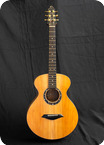Robert Anderson Guitars / Model 04C / Guitar
Features:
Brazilian Rosewood back & sides
Sitka Spruce top
Koa body bindings
Spalted English Maple rosette
Ebony bridge and pins with abalone dot
Ebony fingerboard bound with Koa
Abalone fret markers
Waverly 24k gold tuners
Model 04 starts at
$8500.00,- / Approx. €5675.00,-
Robert Anderson Guitars, Canada 
In over a decade of building lightweight acoustic guitars, I've learned a great deal about how the design, materials and construction affect the voice of the instrument. I've come to appreciate the value of hand crafting each guitar.
I follow the traditions of the old masters, using carefully selected and aged woods, hide glue and dovetail neck joints. For the best possible tone, I then french polish each instrument.
French Polish
I choose to French polish my guitars because it is a very thin and flexible finish and I believe the voice of the instrument is enhanced by it. It is considered to be the most desirable finish for concert classical guitars and I think it equally suited for fine steel string guitars.
I am also influenced in my choice because of the non-toxic nature of the resins and solvent used. The primary ingredient is shellac and the solvent is alcohol. When applied in a well-ventilated space, there is no danger either to my health or to the environment.
Building by hand
I bend the sides, carve the braces, neck and headstock by hand: I hand-thin and tap-tune the soundboard and back. I use hide glue throughout, which requires hand clamping of all the various parts that become the guitar. I finish the guitar by hand scraping, hand sanding and meticulously hand polishing with French Polish.
Building a guitar this way is a slow process, allowing me to focus my attention on each phase of the creation of an individual instrument. My work is mostly intuitive. I tap-tune and listen to the sound the wood makes as I work it in order to understand each particular part of the guitar's voice. In this way, I hope to create a guitar which can truly come to life in the hands of the player.
Tab Tuning
Tap tuning is one of the techniques I use in creating the tone of the guitar. I tap the wood when I obtain it, when I am thicknessing it, when i have joined the plates and when I have installed the braces, prior to final shaving and fitting to the top.
Building Guitars by Hand
I bend the sides, carve the braces, neck and headstock by hand: I hand-thin and tap-tune the soundboard and back. I use hide glue throughout, which requires hand clamping of all the various parts that become the guitar. I finish the guitar by hand scraping, hand sanding and meticulously hand polishing with French Polish.
Building a guitar this way is a slow process, allowing me to focus my attention on each phase of the creation of an individual instrument. My work is mostly intuitive. I tap-tune and listen to the sound the wood makes as I work it in order to understand each particular part of the guitar's voice. In this way, I hope to create a guitar which can truly come to life in the hands of the player.
About my guitars
My guitars are lightweight, small-bodied fingerstyle instruments and are known for their responsiveness and full tonal range. By using carefully selected tonewoods and paying close attention to each individual part of the creation of the instrument, I hope to make a guitar that truly inspires the player. Players across North America and as far away as Japan enjoy these fine hand built musical instruments.
Special Woods
I am particularly pleased to be able to offer some very rare and well aged Seawater Sitka Spruce, BC Englemann and European Spruce top woods.
For tone woods, I have master grade Brazilian Rosewood, AAA grade Koa and Indian Rosewood, as well as beautifully flamed Western Bigleaf Maple and Black Walnut.
Special Woods
I am particularly pleased to be able to offer some very rare and well aged Seawater Sitka Spruce, BC Englemann and European Spruce top woods.
For tone woods, I have master grade Brazilian Rosewood, AAA grade Koa and Indian Rosewood, as well as beautifully flamed Western Bigleaf Maple and Black Walnut.
Seawater Sitka Spruce
I have been fortunate to obtain an exceptional supply of Sitka Spruce which was salvaged from pilings pulled out of the ocean on the east coast of Vancouver Island some 30 years ago. The usable portions of the pilings were quartered and spent the next 25 years air drying. Since 1999, they have resided in my woodshed and I have now split them into billets and am resawing them for tops. They are incredibly resonant and full sounding, with absolutely beautiful tonality. I am calling it Seawater Sitka.













